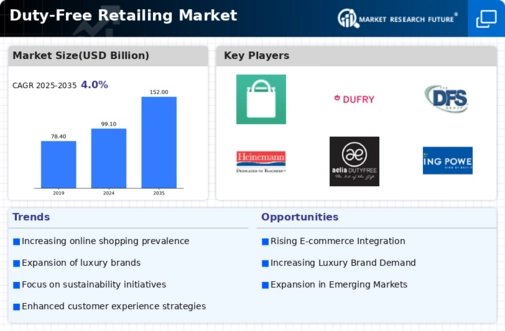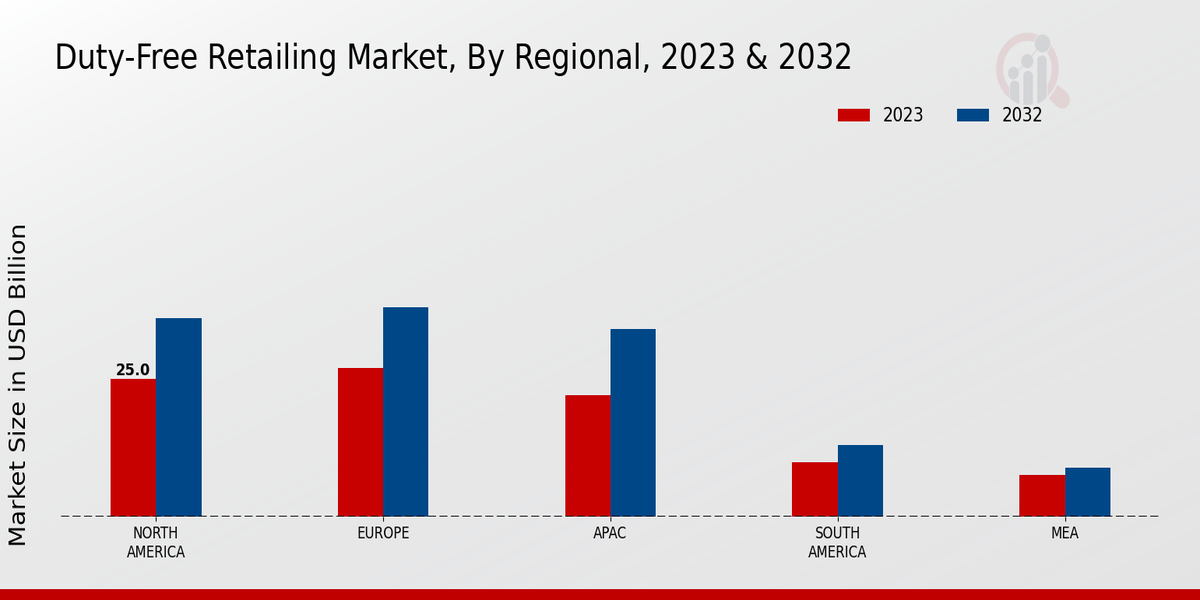Increasing Global Travel
The Global Duty-Free Retailing Market Industry benefits from the rising number of international travelers. In 2024, the market is projected to reach 99.1 USD Billion, driven by a surge in tourism and business travel. As more individuals travel across borders, the demand for duty-free products, including luxury goods, cosmetics, and alcohol, is likely to increase. This trend is particularly evident in regions such as Asia-Pacific, where countries like China and India are witnessing significant growth in outbound tourism. The expansion of airports and travel hubs further facilitates access to duty-free shopping, enhancing the overall market landscape.
Diverse Product Offerings
The Global Duty-Free Retailing Market Industry thrives on the diversity of product offerings available to consumers. Retailers are expanding their portfolios to include a wide range of products, from luxury goods to local specialties. This variety caters to the preferences of different consumer segments, enhancing the appeal of duty-free shopping. For instance, travelers can find unique souvenirs, gourmet foods, and exclusive fragrances that are not available in regular retail outlets. This strategy not only attracts a broader customer base but also encourages higher spending per transaction, contributing to the overall growth of the market.
Market Growth Projections
The Global Duty-Free Retailing Market Industry is poised for substantial growth, with projections indicating a market size of 99.1 USD Billion in 2024 and an anticipated increase to 152.0 USD Billion by 2035. This growth trajectory reflects a compound annual growth rate (CAGR) of 3.97% from 2025 to 2035. Such figures underscore the resilience and potential of the industry, driven by factors such as increasing global travel, evolving consumer preferences, and technological advancements. Stakeholders are encouraged to monitor these trends closely to capitalize on emerging opportunities and navigate the evolving landscape of duty-free retailing.
Evolving Consumer Preferences
Consumer preferences are shifting towards premium and luxury products, which is a crucial driver for the Global Duty-Free Retailing Market Industry. Shoppers increasingly seek high-quality items that are often available at competitive prices in duty-free stores. This trend is evident in the growing popularity of branded cosmetics and high-end spirits. Retailers are adapting their offerings to meet these demands, often collaborating with luxury brands to create exclusive products. As a result, the market is likely to experience growth, with projections indicating a rise to 152.0 USD Billion by 2035. This evolution in consumer behavior underscores the importance of understanding market dynamics.
Technological Advancements in Retail
Technological advancements are reshaping the Global Duty-Free Retailing Market Industry, enhancing the shopping experience for consumers. Innovations such as mobile payment solutions, augmented reality, and personalized marketing strategies are becoming increasingly prevalent in duty-free stores. These technologies not only streamline the purchasing process but also engage consumers in unique ways. For example, the use of mobile apps allows travelers to pre-order products, ensuring a seamless shopping experience. As technology continues to evolve, it is expected to drive growth in the market, aligning with the projected CAGR of 3.97% from 2025 to 2035.
Regulatory Frameworks and Trade Agreements
The Global Duty-Free Retailing Market Industry is influenced by favorable regulatory frameworks and trade agreements that facilitate cross-border shopping. Governments are increasingly recognizing the economic benefits of duty-free sales, leading to the establishment of policies that promote international trade. For instance, the implementation of trade agreements can reduce tariffs and enhance the shopping experience for travelers. Such regulatory support is likely to encourage investment in duty-free retailing, thereby expanding the market. As the industry evolves, it is essential for stakeholders to navigate these frameworks effectively to capitalize on emerging opportunities.










